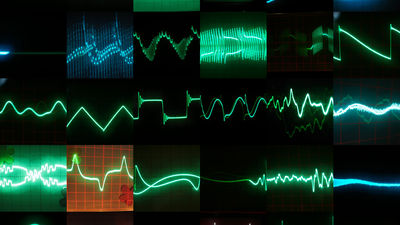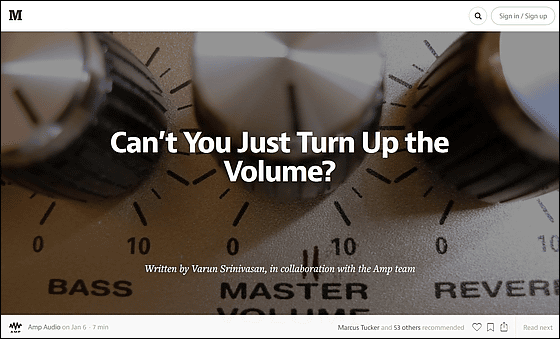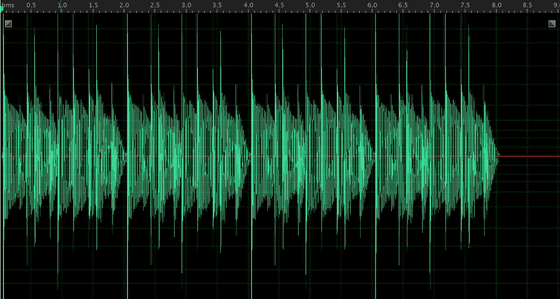What is the structure of a music player application "SoundFocus" made for people with hearing impairment?

ByMikael altemark
"SoundFocus"Is a free music player application that allows people with hearing impairments to listen to music from the iTunes library at all frequencies simply by performing simple audio tests. Since an audio profile is created according to hearing, SoundFocus explains the mechanism in detail, although it is corrected for each "different difficulty to listen" for each user.
Can not You Just Turn Up the Volume? - Medium
https://medium.com/@Amp/cant-you-just-turn-up-the-volume-4ecb7fc422a

In "SoundFocus" that supports people with hearing impairment, many users were asked "From the user why not just raising the volume?" Often the listening ability is sometimes considered to be "a problem of ability to listen to the volume, but it is impossible to keep listening to noise noises that people with normal hearing can listen without problems, The fact that it is not possible to listen to frequencies in a specific area, such as some people can not listen to some of the sounds that can be heard without problems, applies to "hearing loss".
When sound is expressed in three dimensions, time (second), volume (Db/ DB), frequency (Hertz/ Hz) has been configured. The time is defined as "how long the sound lasts" and the volume is defined as "how big is the sound", but the frequency is a matter that requires supplementary explanation "how many times a sound wave oscillates every second"?
"Rubbing sound like an engine" is mainly composed of low frequency, it oscillates about 100 times per second. In contrast, cymbal "crisp sound" is made up of high frequencies, and it is possible to classify frequencies by frequency, such as oscillating more than 10,000 times per second. All sounds heard in the ears, such as "Cork pull out sound" "sneeze", etc. are heard as a combination of "specific time length", "specific volume", "some frequencies", three factors fluctuate By doing so you can hear a different sound.
"Waveform" which is frequently seen in music players etc. is a two-dimensional visualization of sound with "time" and "volume". "Frequency" of the sound existing on three dimensions is not visualized.

Since frequency is an important factor in hearing loss, in order to grasp the sound frequency,Fast Fourier Transform, You can use "Frequency Graph" which allows visualization of sound two-dimensionally with frequency and volume.

The graph is the ratio of the minimum value and the maximum value of distinguishable soundsDynamic rangeThis means that you will be able to know in which area of the sound you are losing your hearing. The minimum value of sounds that humans can listen to is 0 dB (the degree of dropping a pin on the floor) to the maximum value is 120 dB (Metallica's concert), it can not be heard if it is 0 dB or less, and if it is 120 dB or more I feel pain.
On the other hand, it is a range where a human can perceive vibration as soundAudible rangeIt is said that children are 20 Hz to 20 kHz (20,000 Hz). The most interesting thing is that the beginning of hearing loss is said to occur more frequently, especially for high-pitched sounds, and various factors are intertwined with people's way of hearing sound.
If the hearing in a specific frequency range suffers loss, the sensitivity of the sound in that frequency band decreases, but the sensitivity of sound volume does not change. This means that hearing loss means "it is not simply the volume of the volume", it is also a part which is likely to be misleading. People with hearing loss have an unusual audible range pattern, and if there are two people who suffer from hearing impairment, it means that they are distinguishing sounds with different audible range patterns.
SoundFocus is comparing hearing loss using the image image of the bear who got on the tricycle below.

An image in which the lower side of the image is cut and the tricycle becomes invisible shows the state in which the dynamic range is lost.

Even if the cut image is enlarged, naturally the part of the tricycle remains invisible. This is just the same as raising the sound volume.

So if you compress all the bears and tricycles in the same range as the image above, the shape will change, but you could see the whole body of the bear even in the same field of view. It is used in the hearing aid industry to compensate for the loss of hearing "Multiband CompressionIt is the same as the process performed by "

By including the sound data in the inaudible range within the dynamic range according to the audible range possessed by people with hearing loss by compression, you will hear sounds that are not exactly the same, but can not be heard. The same effect is impossible to reproduce with simple equalizer and volume control. To see what happens when you actually perform multiband compression, first listen to the uncompressed sound source that reproduces the state of the person with the following hearing loss.
Subsequently, when listening to the sound source compressed with multi-band compression, you can see that not only the beat of the drum, but also the treble cymbal sound can be heard firmly.
The waveform of "time" and "volume" of the following uncompressed sound source.

Looking at the waveform of the compressed sound source, you can see that the waveform that was growing greatly upwards and downwards when compressed is compressed in the middle, and it falls within the range of the dynamic range that is easy to hear.

The application "SoundFocus" for people with hearing loss is that music is compressed according to the user by recognizing the difference between specific frequency and dB hearing different from person to person by audio test. Since the audio test is about 1 minute, even if it is not only a person with hearing loss but also "you are dissatisfied with the music player you use", you can enjoy music with audible range and dynamic range tuned for each user That's it.
SoundFocus for iPhone, iPod touch, iPad currently on the iTunes App Store
https://itunes.apple.com/jp/app/soundfocus/id670086460
Also, a speaker for iPhone made by SoundFocus who thought thoroughly about hearing "Amp"Has also appeared, we accept pre-order with a 40% discount price. Color can be selected for 2 colors of white and black, for iPhone 5 / 5s / 6/6 Plus. The price is 79 dollars (about 9300 yen), and dispatch to Japan requires a separate $ 15 (about 1700 yen). It is a limited time price until January 14 (Wednesday) 2015 in Japan time.
Amp - Your Phone Has Never Sounded Better
https://www.ampaudio.com/

Related Posts:







